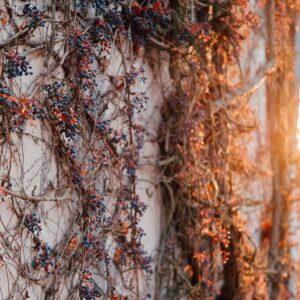Espalier, the art of training fruit trees against a flat surface, transforms gardens into living galleries. This technique optimises space and enhances fruit quality. It requires patience, care, and some specialised tools, making it a rewarding endeavor for garden enthusiasts.
Espalier is a gardening technique where trees are trained to grow in flat planes against walls, fences, or trellises. This practice dates back centuries, originally developed to promote fruit production in limited spaces and to decorate stone walls and fences. Today, gardeners embrace Espalier for its ability to produce fruit in small areas, its decorative appeal, and the way it allows for easier harvesting and maintenance. It’s crucial to understand the different patterns Espalier can take, such as the horizontal cordon, the fan, and the Belgian fence, each suited to various types of trees and garden spaces.

The espalier technique has been around for centuries.
Choosing the right time for planting and training trees is crucial for their success. The best seasons to plant fruit trees are late winter or early spring, just before new growth starts. This timing gives the trees a chance to establish roots in their new location before the growing season begins.
For gardening enthusiasts planning a move, considering relocation during the winter can be advantageous. Not only are moving rates typically lower, but it also aligns perfectly with the planting season. And moving with expertise help on your side, like the one offered by usmovingexperts.com can make the transition smoother. They aim to simplify your relocation by connecting you with the best movers, allowing you to focus on planting and training your new fruit trees with ease as spring arrives.
Not all fruit trees are suitable for Espalier. Apples and pears, for instance, are more adaptable to this method due to their flexible branches and robust nature. When selecting trees for Espalier, understanding soil health is as important as the tree type. Healthy soil promotes strong growth and reduces disease risk, ensuring your special project is successful from the start. Choose young and flexible trees, as they can be more easily trained into desired shapes.
After choosing the right tree, the next step is to prepare the site. This involves selecting a location that receives adequate sunlight, vital for fruit production. Then, install a support system to guide the tree’s growth, such as a trellis or wires stretched between posts. Begin training the tree early in its life, attaching branches to the support structure and pruning as necessary to encourage the tree to grow in the desired pattern. Patience is key, as it can take several years for an espalier tree to fully mature.
Training fruit trees requires a mix of skill, patience, and creativity. Start by selecting a young tree and decide on the pattern you want to achieve. Tying branches to the support structure as the tree grows, guiding them to grow in the desired direction. Pruning plays a crucial role in Espalier. Remove any growth that doesn’t fit the pattern or competes with the tree’s main form. Regular pruning shapes the tree and improves air circulation and light penetration, which is essential for fruit production. Additionally, keep an eye on your tree’s health, promptly addressing any signs of pests or disease to ensure your efforts in training fruit trees lead to a bountiful harvest.

Pruning is what gives the espalier its unique look.
When training fruit trees, gardeners often face several challenges, but with the right approach, you can overcome them. Common issues include pests, diseases, and environmental stresses.
Espalier is a fantastic way to downsize and simplify your garden while still enjoying the beauty and bounty of fruit trees. This method is perfect for small gardens, patios, or even balconies where space is premium. By training fruit trees against a wall or trellis, you can maximise vertical space and grow various fruits in a compact area. For example, an espalier apple tree can produce as much fruit as a traditionally grown apple tree but in a fraction of the space. This makes Espalier an ideal solution for urban gardeners looking to develop their own fruit.
Espalier transforms fruit trees into living sculptures, blending art and horticulture. This method allows gardeners to create visually striking patterns on walls or fences, turning an ordinary garden into a stunning outdoor gallery. From the simple elegance of a single horizontal line to the intricate patterns of a Belgian fence, Espalier offers endless possibilities for creativity. Moreover, as the seasons change, so does the appearance of your espalier trees, providing a dynamic element to your garden design.
Advanced espalier projects offer exciting challenges for those ready to take their skills in training fruit trees to the next level. These might include creating multi-tiered designs or combining different species of fruit trees in one Espalier. One innovative project is the “fruit salad” espalier, where different types of fruit trees, such as apple, pear, and cherry, are grafted onto a single root-stock and trained into an espalier form. This saves space and provides a variety of fruits from a single tree.

Training fruit trees takes time and skill.
The art of training fruit trees combines gardening skills with creative expression, offering a unique way to enhance any outdoor space. Whether dealing with a small city garden or looking to add a decorative element to your landscape, Espalier is a versatile and rewarding technique. By understanding the basics, choosing the right trees, and facing challenges with resilience, you can create a living masterpiece that is both beautiful and fruitful.